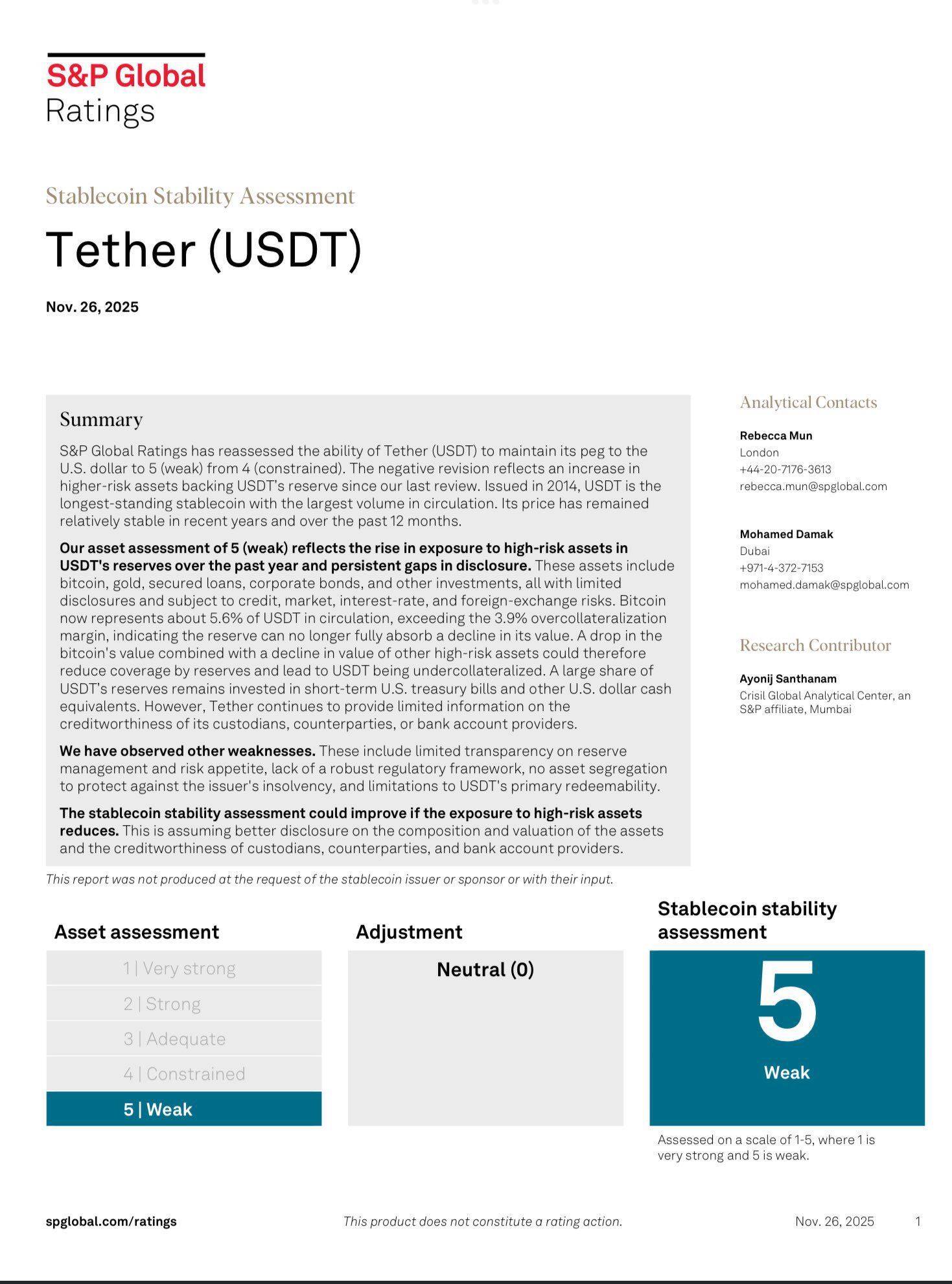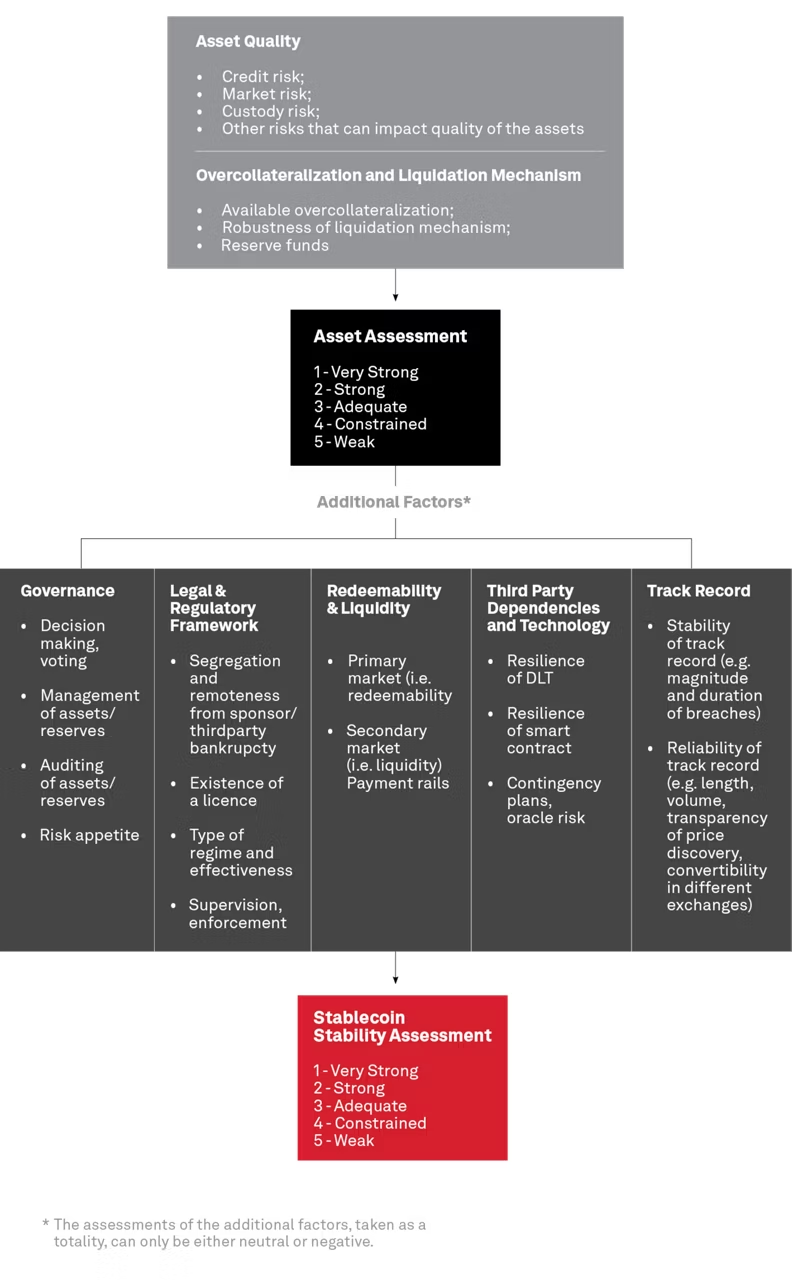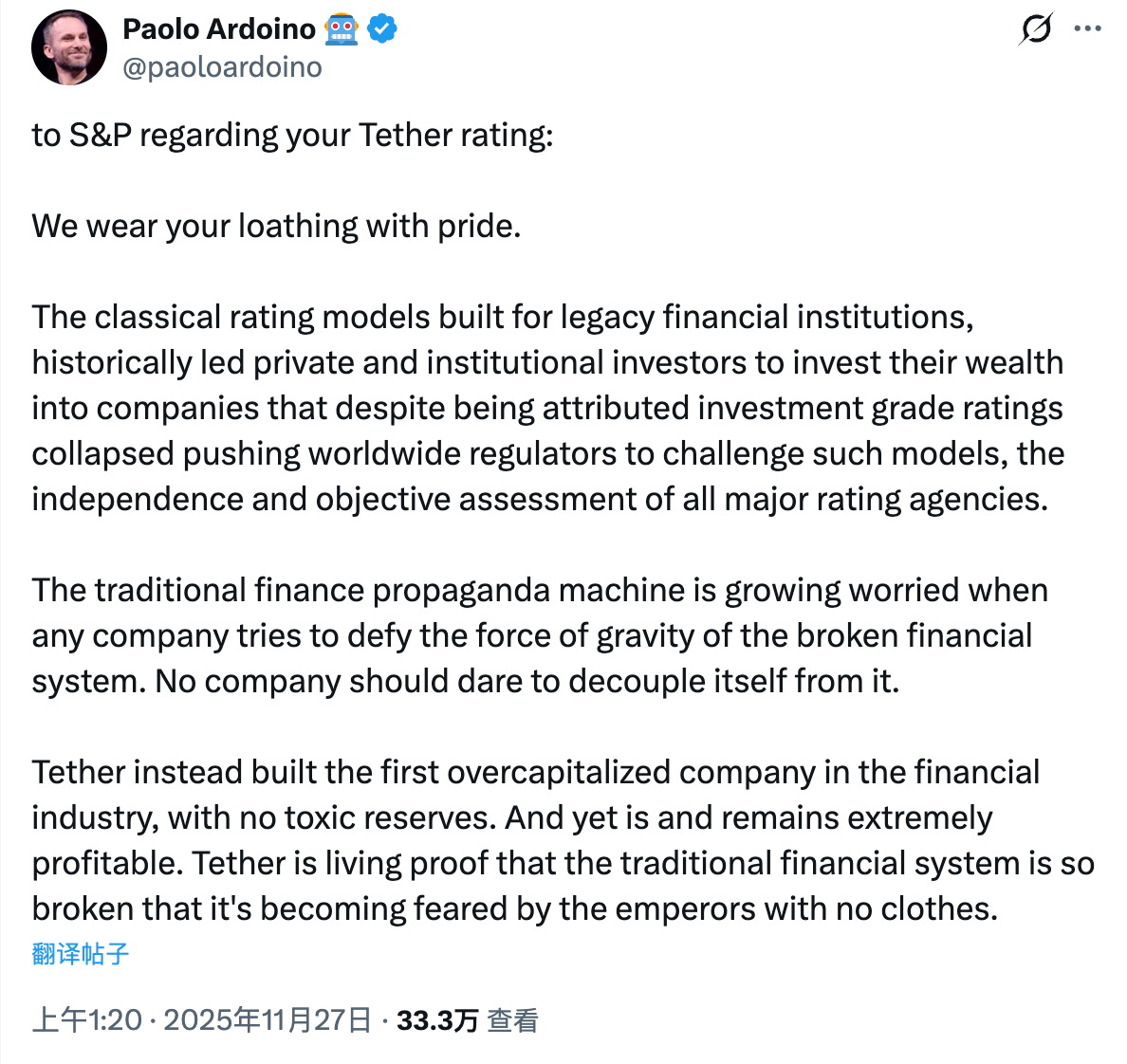Original | Odaily Planet Daily (@OdailyChina)

On November 26, Eastern Time, the top rating agency S&P Global announced that it has downgraded the rating of stablecoin giant Tether (USDT) from "4" (restricted) to "5" (vulnerable), which is the lowest level in its rating system.
This follows a shocking negative rating result given by S&P to another industry leader, Strategy — see "S&P gives Strategy a B- rating, why is the DAT leader viewed as junk by institutions?."

S&P's Rating Standards
S&P, along with Moody's and Fitch, is one of the world's three major rating agencies and is recognized as one of the most authoritative credit rating agencies in the international financial market. According to S&P's official introduction, its stability assessment system for stablecoins aims to provide market participants with transparency regarding the stability of various stablecoins and specifically analyzes their decoupling risks in depth.
Specifically, S&P's analytical approach consists of the following steps:
- First, a risk assessment of asset quality is conducted, including credit risk, market value, and custody risk;
- Next, the excess collateral requirements and liquidation mechanisms of major stablecoins are further analyzed to determine how much these can mitigate the risks (shown in the light gray box in the image below);
- After considering these factors, S&P assigns an asset quality score to each stablecoin ranging from 1 to 5 (extremely strong, strong, adequate, restricted, vulnerable) (shown in the black box in the image below);
- Upon completing the asset quality assessment, S&P will also consider five additional dimensions: governance mechanisms, legal and regulatory frameworks, redemption capabilities and liquidity, technology and third-party dependencies, and historical records (shown in the dark gray box in the image below);
- The strengths and weaknesses of these five dimensions will collectively form an overall risk assessment view, which will influence the final score of each stablecoin (shown in the red box in the image below).

Reasons for Tether (USDT) Rating
In the announcement regarding the downgrade of Tether (USDT), S&P stated that the downgrade reflects an increase in high-risk assets supporting USDT since the last assessment, as well as ongoing issues with Tether's information disclosure.
S&P elaborated that the so-called high-risk assets include Bitcoin, gold, secured loans, corporate bonds, and other investments, all of which have limited information disclosure and face credit risk, market risk, interest rate risk, and foreign exchange risk. Currently, Tether's Bitcoin reserves account for about 5.6% of the total circulation of USDT, exceeding the 3.9% excess collateral rate of USDT itself, which means that other low-risk reserve assets can no longer fully support the value of USDT. If the value of BTC and other high-risk assets declines, it may weaken the coverage capability of USDT's reserves, leading to insufficient collateral for USDT. As for other low-risk reserve assets, a significant portion is invested in short-term U.S. Treasury bonds and other dollar cash equivalents; however, Tether has consistently faced disclosure issues regarding custodians, counterparties, or bank account providers.
S&P added that, in addition to the main reasons mentioned above, the agency believes that Tether (USDT) also has limited transparency in reserve management and risk preferences, lacks a sound regulatory framework, has no asset segregation to prevent issuer bankruptcy, and has restrictions on the redeemability of USDT.
In the final rating, S&P also mentioned the possibility of a rating adjustment for Tether (USDT) — if the exposure to high-risk asset reserves decreases and Tether can improve its information disclosure, it may enhance the assessment of its stability.
Ratings of Other Stablecoins
In addition to Tether, S&P has also rated various mainstream stablecoins such as USDC and USDe, with the following results:
- Circle (USDC): 2 (strong);
- Circle (EURC): 2 (strong);
- First Digital USD (FDUSD): 4 (restricted);
- TrueUSD (TUSD): 5 (vulnerable);
- Gemini USD (GUSD): 2 (strong);
- Paxos USD (USDP): 2 (strong);
- EUR Coinvertible (EURCv): 3 (adequate);
- Mountain Protocol USD (USDM): 3 (adequate);
- Ethena (USDe): 5 (vulnerable);
- Sky Protocol (USDS/DAI): 4 (restricted);
- Frax (FRAX): 5 (vulnerable);
From the above, it is clear that S&P shows a clear preference for centralized stablecoins with excess collateral and higher transparency (such as USDC), while holding a relatively pessimistic view of mainstream decentralized stablecoins (like USDe and USDS) — this is understandable, as the rating logic in the first two parts shows that S&P categorizes crypto assets like BTC as high-risk, which is often a major component of decentralized stablecoin collateral.
Tether's Response
After S&P announced the rating adjustment for Tether (USDT), Tether CEO Paolo Ardoino strongly responded on the X platform, stating: "We take pride in your hatred."
Paolo Ardoino further stated that the classical rating models used by traditional financial institutions have led countless private and institutional investors to invest their wealth in companies that, despite receiving investment-grade ratings, ultimately collapsed, prompting global regulators to begin questioning the independence and objectivity of these models and all mainstream rating agencies. When companies attempt to break free from the gravity of a flawed financial system, the traditional financial propaganda machine becomes increasingly anxious. No company dares to attempt to escape this system. In this context, Tether has created the first capital-rich company in the financial industry, without any toxic asset reserves, and it remains highly profitable. Tether's existence proves that the traditional financial system is riddled with flaws, and even those "naked emperors" feel fear.

Will it affect USDT?
Looking back at S&P's rating statement for Tether (USDT), aside from the changes in the proportion of BTC reserves, S&P repeatedly mentioned Tether's information disclosure issues.
Due to its offshore nature and some historical operational factors, Tether has always faced certain controversies regarding transparency. Compared to its largest competitor USDC, it is an objective fact that USDT has insufficient disclosure in reserves, audits, etc., but due to its unique liquidity conditions (especially since almost all CEXs use USDT as the base settlement currency), along with its excellent historical performance and strong financial status, the market still highly trusts and even relies on USDT — supported by strong network effects, USDT remains firmly seated on the throne of the stablecoin arena.
As overseas KOL Novacula Occami commented: “… insufficient information disclosure has long been a problem for Tether, but they neither can nor intend to solve it.”
Clearly, a single attitude from S&P is not enough to shake USDT's market position. However, it is worth noting that Tether has previously announced that it will launch a stablecoin USAT for the U.S. market in December, which has strict regulations regarding reserve status, regulatory registration, disclosure mechanisms, and redemption terms through the GENIUS Act, and these requirements align closely with S&P's rating standards. If Tether wants to successfully promote USAT in the U.S. later, it may still need to consider S&P's ratings to some extent.

Today, after Paolo Ardoino's strong response to S&P, Tether's USAT business head Bo Hines also followed up with a strong criticism, stating, "The dysfunction of the system will breed institutional jealousy," but while criticism is one thing, Paolo Ardoino may not need to care about S&P, Bo Hines really needs to think about how to specifically address the issues raised by S&P.
免责声明:本文章仅代表作者个人观点,不代表本平台的立场和观点。本文章仅供信息分享,不构成对任何人的任何投资建议。用户与作者之间的任何争议,与本平台无关。如网页中刊载的文章或图片涉及侵权,请提供相关的权利证明和身份证明发送邮件到support@aicoin.com,本平台相关工作人员将会进行核查。




